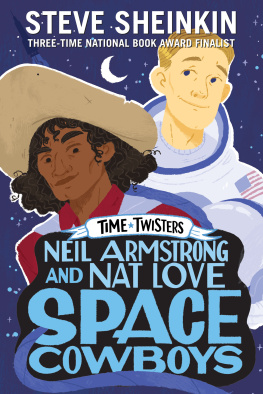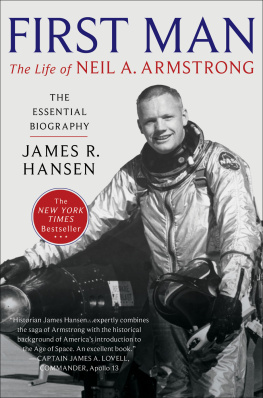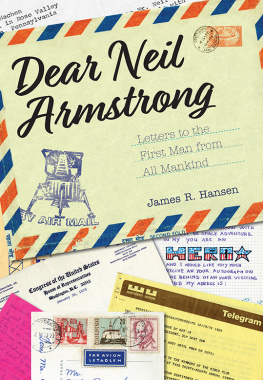James R. Hansen - First Man: The Life of Neil A. Armstrong
Here you can read online James R. Hansen - First Man: The Life of Neil A. Armstrong full text of the book (entire story) in english for free. Download pdf and epub, get meaning, cover and reviews about this ebook. year: 2005, publisher: Simon and Schuster, genre: Non-fiction. Description of the work, (preface) as well as reviews are available. Best literature library LitArk.com created for fans of good reading and offers a wide selection of genres:
Romance novel
Science fiction
Adventure
Detective
Science
History
Home and family
Prose
Art
Politics
Computer
Non-fiction
Religion
Business
Children
Humor
Choose a favorite category and find really read worthwhile books. Enjoy immersion in the world of imagination, feel the emotions of the characters or learn something new for yourself, make an fascinating discovery.
- Book:First Man: The Life of Neil A. Armstrong
- Author:
- Publisher:Simon and Schuster
- Genre:
- Year:2005
- Rating:5 / 5
- Favourites:Add to favourites
- Your mark:
- 100
- 1
- 2
- 3
- 4
- 5
First Man: The Life of Neil A. Armstrong: summary, description and annotation
We offer to read an annotation, description, summary or preface (depends on what the author of the book "First Man: The Life of Neil A. Armstrong" wrote himself). If you haven't found the necessary information about the book — write in the comments, we will try to find it.
First Man: The Life of Neil A. Armstrong — read online for free the complete book (whole text) full work
Below is the text of the book, divided by pages. System saving the place of the last page read, allows you to conveniently read the book "First Man: The Life of Neil A. Armstrong" online for free, without having to search again every time where you left off. Put a bookmark, and you can go to the page where you finished reading at any time.
Font size:
Interval:
Bookmark:
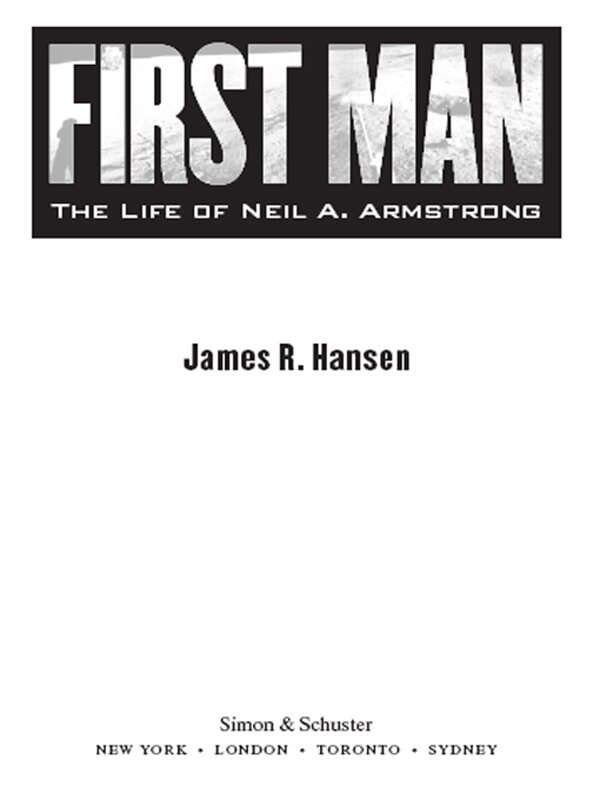

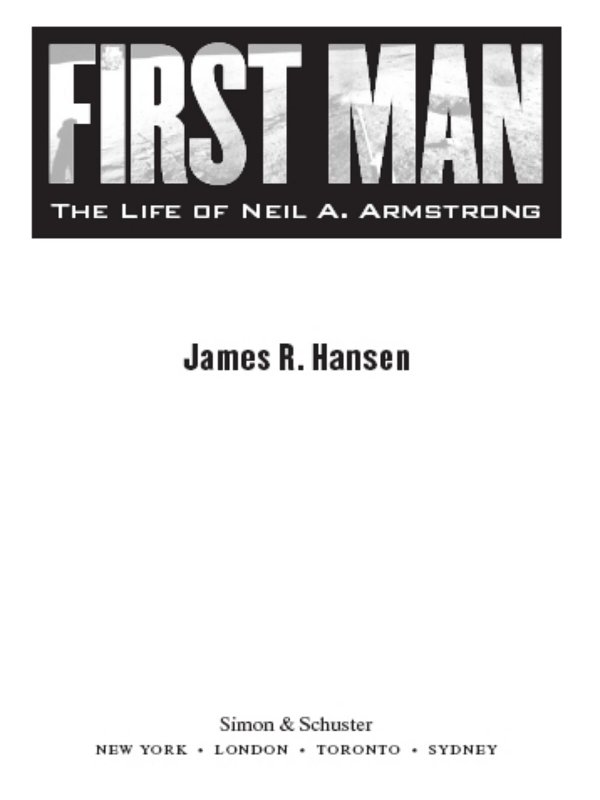

SIMON & SCHUSTER
Rockefeller Center
1230 Avenue of the Americas
New York, NY 10020
Copyright 2005 by James R. Hansen
All rights reserved,
including the right of reproduction
in whole or in part in any form.
SIMON & SCHUSTER and colophon are registered trademarks of Simon & Schuster, Inc.
Library of Congress Cataloging-in-Publication Data
Hansen, James R.
First man : the life of Neil A. Armstrong / James R. Hansen.
p. cm.
Includes bibliographical references and index.
1. Armstrong, Neil, 1930 2. AstronautsUnited StatesBiography. 3. Project Apollo (U.S.) 4. Space flight to the moon. I. Title.
TL789.85.A75H36 2005
629.45'0092dc22
[B] 2005049992
ISBN-13: 978-0-7432-8171-3
ISBN-10: 0-7432-8171-3
Visit us on the World Wide Web:
http://www.SimonSays.com
For Jennifer and Nathan
The privilege of a lifetime is being who you are.
JOSEPH CAMPBELL, REFLECTIONS
ON THE ART OF LIVING
CHAPTER 4 The Virtues of Small
ville
CHAPTER 6 Aeronautical Engi
neering 101
PART FOUR: THE REAL RIGHT
STUFF
PART FIVE: NO MAN IS AN
ISLAND
CHAPTER 26 Dialectics of a Moon
Mission
PART EIGHT: DARK SIDE OF THE
MOON
T HE L AUNCH
After the Moon mission was over and the Apollo 11 astronauts were back on Earth, Buzz Aldrin remarked to Neil Armstrong, Neil, we missed the whole thing.
Somewhere between 750,000 and 1 million people, the largest crowd ever for a space launch, gathered at Floridas Cape Kennedy in the days leading to Wednesday, July 16, 1969. Nearly a thousand policemen, state troopers, and waterborne state conservation patrolmen struggled through the previous night to keep an estimated 350,000 cars and boats flowing on the roads and waterways. One enterprising state auto inspector leased two miles of roadside from orange growers, charging two bucks a head for viewing privileges. For $1.50 apiece, another entrepreneur sold pseudo-parchment attendance certificates with simulated Old English lettering; an additional $2.95 bought a pseudo space pen.
No tailgate party at any Southeastern Conference football game could match the summer festival preceding the first launch for a Moon landing. Sunglassed spectators dressed in Bermuda shorts or undressed in bikinis, even at this early hour firing up barbecue grills, opening coolers of beer and soda pop, peering through binoculars and telescopes, testing camera angles and lensespeople filled every strand of sand, every oil-streaked pier, every fish-smelling jetty.
Sweltering in 90-degree heat by midmorning, bitten up by mosquitoes, still aggravated by traffic jams or premium tourist prices, the great mass of humanity waited patiently for the mammoth Saturn V to shoot Apollo 11 toward the Moon.
In the Banana River, five miles south of the launch complex, all manner of boats choked the watercourse. Companies such as Grumman Aircraft had hired the larger charters for the day to give their employees a chance to witness the product of their years of effort. Aboard a large cabin cruiser, the Grapefruit II, wealthy citrus grower George Lier of Orchid Island, Florida, playfully tossed grapefruit at passersby. Just offshore, two small African-American boys sat in a ramshackle rowboat casually watching the mayhem that was making it so hard to catch any fish.
On a big motor cruiser owned by North American Aviation, builder of the Apollo command module, Janet Armstrong, the wife of Apollo 11s commander, and her two boys, twelve-year-old Rick and six-year-old Mark, stood nervously awaiting the launch. Fellow astronaut Dave Scott, Neils mate on the Gemini VIII flight in 1966, had arranged what Janet called a numero uno spot. Besides Scott, two of Janets friendsPat Spann, a neighbor from El Lago, Texas, whose husband worked in the Manned Spacecraft Centers Mission Support Office, and Jeanette Chase, who helped Janet coach the synchronized swimming team at the El Lago Keys Club and whose husband served in the Recovery Division at MSCwere also on board, as were a few NASA public affairs officers and Dora Jane (Dodie) Hamblin, a journalist with exclusive coverage of the personal side of the Apollo 11 story for Life magazine.
Above them all, helicopters ferried successive groups of VIPs to reserved bleacher seating in the closest viewing stands a little more than three miles away from the launchpad. Of the nearly 20,000 on NASAs special guest list, about one-third actually attended, including a few hundred foreign ministers, ministers of science, military attachs, and aviation officials, as well as nineteen U.S. state governors, forty mayors, and a few hundred leaders of American business and industry. Half the members of Congress were in attendance, as were a couple of Supreme Court justices. The guest list ranged from General William Westmoreland, the U.S. army chief of staff in charge of the war in Vietnam, and Johnny Carson, the star of NBCs Tonight Show, to Leon Schachter, head of the Amalgamated Meat Cutters and Butcher Workers, and Prince Napoleon of Paris, a direct descendant of the emperor Napoleon.
Vice President Spiro T. Agnew sat in the bleachers while President Richard M. Nixon watched on TV from the Oval Office. Originally, the White House had planned for Nixon to dine with the Apollo 11 astronauts the night before liftoff, but the plan changed after Dr. Charles Berry, the astronauts chief physician, was quoted in the press warning that there was always a chance that the president might unknowingly be harboring an incipient cold. Armstrong, Aldrin, and the third member of their crew, Mike Collins, thought the medical concern was absurd; if the truth be known, twenty or thirty peoplesecretaries, space suit technicians, simulator technicianswere coming into daily contact. Apollo 8s Frank Borman, whom NASA had designated as Nixons special space consultant, assailed Berrys warning as totally ridiculous and damned stupid but stopped short of arguing for another reversal of plans, because if anyone sneezes on the Moon, theyd put the blame on the president.
Two thousand credentialed reporters watched the launch from the Kennedy Space Center press site. Eight hundred and twelve came from foreign countries, 111 from Japan alone. A dozen journalists came from the Soviet bloc: seven from Czechoslovakia, three from Yugoslavia, and two from Romania.
Landing on the Moon was a shared global event which nearly all humankind felt transcended politics. British papers used two- and three-inch high type to herald news of the launch. In Spain, the Evening Daily Pueblo, though critical of American foreign policy, sent twenty-five contest winners on an all-expense-paid trip to Cape Kennedy. A Dutch editorialist called his country lunar-crazy. A Czech commentator remarked, This is the America we love, one so totally different from the America that fights in Vietnam. The popular German paper Bild Zeitung noted that seven of the fifty-seven Apollo supervisors were of German origin; the paper chauvinistically concluded, 12 percent of the entire Moon output is made in Germany. Even the French considered Apollo 11 the greatest adventure in the history of humanity. France-Soir s twenty-two-page supplement sold 1.5 million copies. A French journalist marveled that interest in the Moon landing was running so high in a country whose people are so tired of politics and world affairs that they are accused of caring only about vacations and sex.
Font size:
Interval:
Bookmark:
Similar books «First Man: The Life of Neil A. Armstrong»
Look at similar books to First Man: The Life of Neil A. Armstrong. We have selected literature similar in name and meaning in the hope of providing readers with more options to find new, interesting, not yet read works.
Discussion, reviews of the book First Man: The Life of Neil A. Armstrong and just readers' own opinions. Leave your comments, write what you think about the work, its meaning or the main characters. Specify what exactly you liked and what you didn't like, and why you think so.







